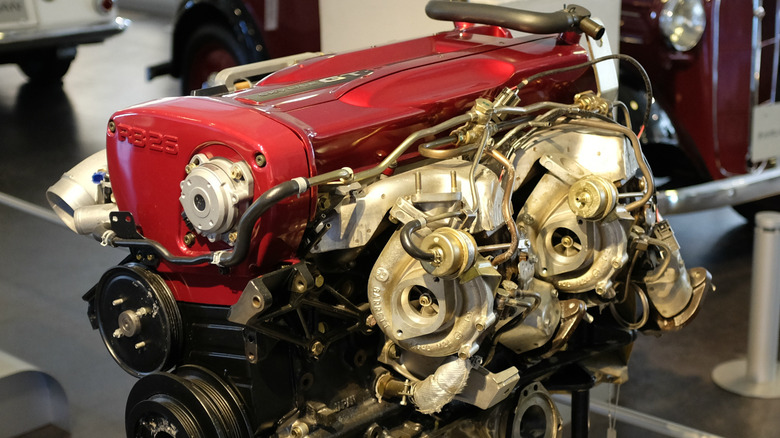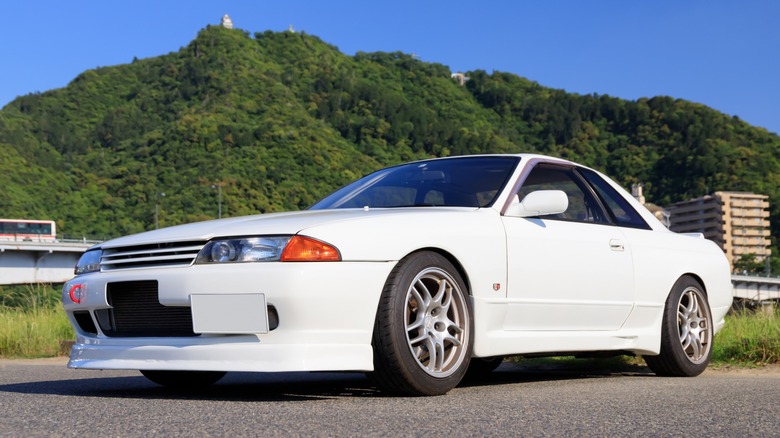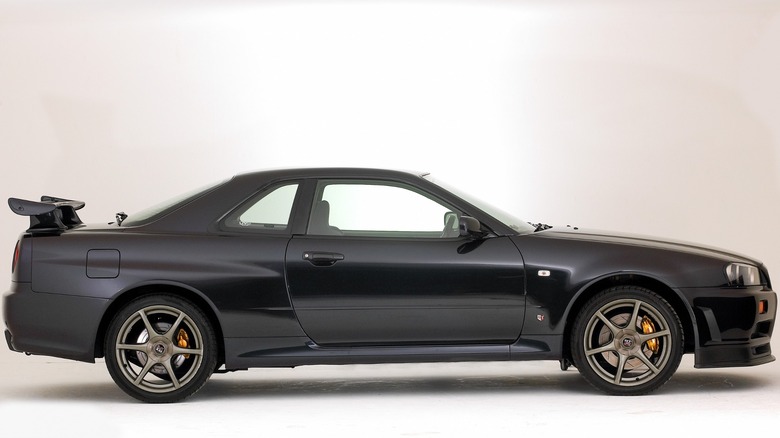Here's What Made Nissan's RB26DETT Inline-6 Engine So Legendary
Movies, video games, and all sorts of motorhead media love to feature classic Japanese sports cars from the 1990s. Perhaps the most admired of the bunch is the '90s lineup of Nissan Skyline GT-Rs. The iconic R32, R33, and R34 models all have one thing in common beyond a Skyline badge and ludicrous speed: the RB26DETT inline six-cylinder engine.
The Nissan RB engine family was born in the mid-1980s, getting its acronym from "Response Balance." The first RB engine found its way under the hood of the fifth-generation Nissan Laurel and eventually went on to become one of the most iconic engine platforms in tuner car history. The engine's use in legendary platforms like the Skyline GT-Rs and enduring popularity in the tuning scene has made the RB26DETT an iconic piece of Japanese automotive history.
[Featured image by RocketJohn via Wikimedia Commons | Cropped and scaled | CC BY 4.0]
RB26DETT meaning and history
Aside from the above-mentioned "Response Balance" namesake, the rest of the engine code is representative of a few things. The "26" in RB26DETT signifies that the engine has 2.6 liters of displacement and the "D" means a dual-overhead-camshaft layout. The E signifies that it uses electronic fuel injection, and the TT tells us that it is twin-turbocharged.
The RB26DETT made its first appearance when Nissan engineers decided to resurrect a legend. For the first time in decades, the trim level "GT-R" was coming back to the Skyline namesake. The R32 Nissan Skyline GT-R roared out of the gate in 1989, quickly garnering the nickname "Godzilla" in the racing world as an unstoppable Japanese giant. While the R32 Skyline GT-R's all-wheel-drive system definitely deserves credit, the RB26DETT engine was the literal driving force of its success.
The RB26DETT in the R32 GT-R made "276 horsepower." Those quotation marks merit a quick history lesson. In the late '80s, Japanese automakers entered a "gentleman's agreement" to limit all performance cars to 276 horsepower for the benefit of public safety. Suspiciously, though, plenty of "276 horsepower" cars, when put on dynos, made a bit more than that. Sometimes more than a bit! Accidental, no doubt. We're sure it was just coincidental that there was an active global market for compact, blisteringly fast Japanese sports cars at the time.
What makes the RB26DETT so great?
On the back of the R32 GT-R's monumental success, the continuation of the Skyline lineup through the R33 and R34 generations still used the RB26DETT in the GT-R. Perhaps most notably, the R34 gained a ton of public admiration after its superstar role in the "Fast and Furious" movie franchise.
The R33 Nissan Skyline is a bit underloved compared to the R32 and R34, despite coming with the most powerful variant of the RB26 to date. The RBX-GT2 was used for the ultra-exclusive R33 Nissan Skyline 400R and completely disregarded the gentleman's agreement. With 400 horsepower, it's one of the most desirable Skyline models on the market.
Though the R34 GT-R also had "276 horsepower," it was perhaps the best example of the RB26DETT to leave the factory. Ball-bearing turbochargers and a dual-mass flywheel made for perhaps the most responsive and potent of the RB26 Skylines.
The RB26DETT gets its iconic status from its position as powerplant for some of the most celebrated Japanese sports cars in history. R34 GT-Rs routinely bring in six-figure prices per Bring a Trailer, and the RB26 itself is a robust tuning platform ready to swap into all sorts of vehicles. Tough cast-iron construction and substantial aftermarket support mean the sky is the limit in terms of power upgrades, to the point that some tuners get 1000hp or better from Nissan's little six-cylinder. Not bad for a "276 horsepower" engine.


